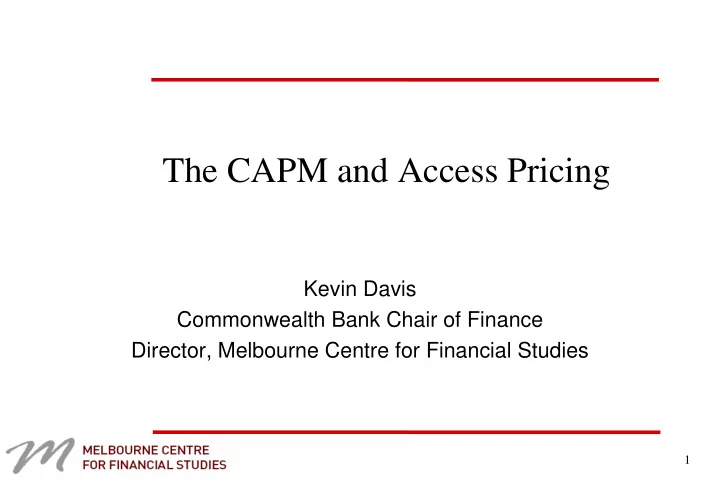

The CAPM and Access Pricing Kevin Davis Commonwealth Bank Chair of Finance Director, Melbourne Centre for Financial Studies 1
Possible reasons not to use the CAPM • Not theoretically robust • Empirical failure • Not used in practice • Real world imperfections create implementation problems (tax, international v domestic) • Can’t calibrate (estimate) parameters • Ignores real options • Ignores asymmetric risk / asset stranding • There exist better alternatives 2
Theory and the CAPM • An internally logically consistent model – But all models are approximations of reality • A more general model is the Intertemporal CAPM – Implies additional (unspecified) risk factors • Proxies for change in future investment opportunity set • But what are the factors? – Maybe Fama-French book-market (HML) and small-large (SMB) – Or others (Brennan focuses on changes in risk free rate and Sharpe ratio) • How important are these other factors relative to the market factor? 3
Empirical Failure • “Consensus” that CAPM doesn’t fully explain pricing of risky assets – Based on studies of stock returns – Fama-French SMB and HML factors have become popular • But do they proxy for risk factors? • Should we expect CAPM to completely explain returns on stocks? – Assets in place plus real options • Can this explain “problem” of time-varying betas? 4
Not Used in Practice? • Graham and Harvey (2001) US survey of 392 CFOs – 73.5% always or almost always use the CAPM – A small number make some adjustments • Coleman, Maheswaran and Pinder (2008) survey of Australian CFOs – over 70% of respondents always or almost always utilize the standard CAPM – just over 30% of those that estimate the cost of equity utilize some multi-factor version of the CAPM. • Does it matter? It’s a positive theory, not normative. 5
Real World Imperfections • There is a range of CAPM models which can be chosen from • Tax – Dividend imputation “Monkhouse CAPM” – Capital Gains Tax “Lally-van Zjl CAPM” • International Markets – Tax differences – Defining the market portfolio 6
Calibration Problems • Even if we have the right model, there are externally determined, possibly unknown, parameters • Risk free rate = ? • Market risk premium = ? • Beta = ? But these types of issues arise in all models 7
Real Options • Real options are important • May help explain “failure” of asset pricing tests using returns on stocks which are portfolios of existing assets and real options – CAPM may provide good estimate of cost of capital – Investment decisions still need to incorporate real options • Fundamental issue is – Real options involve a private ownership right – Should Access pricing endow/endorse access providers with ownership rights to future investment projects? – How to achieve social v private optimal investment decisions? 8
Asymmetric risk / stranding • Not inconsistent with CAPM – Estimating required returns of ultimate, diversified, investor – not of manager • Investor’s mean-variance preferences for portfolio returns not inconsistent with individual projects having asymmetric returns • An issue of application of building block model – Expected cash flows should be calculated allowing for probability of project failure • Not expected cash flows “given success” • “Problem” that ex post successful ventures then generate politically sensitive excess returns. 9
Better alternatives? • In theory – yes – Other more general asset pricing models – estimated using “backward looking” data – Implied cost of capital – “forward looking” • In practice - ?? – Even with right model, unknown parameters and variable risk/time preferences mean none of us know true cost of capital – Which asset pricing model provides best framework for the game being played? 10
Recommend
More recommend